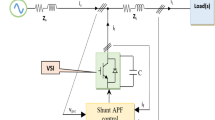Abstract
This paper proposes a new control strategy for three-phase three-wire shunt active power filters. The idea in this strategy is to form an energy-like Lyapunov function in terms of the active filter states and then determine the control law that makes the time derivative of the Lyapunov function always negative for all values of the states. It is shown analytically that a globally stable control is possible. The references for the active filter currents are obtained by subtracting the measured load currents from the generated source current references. The amplitude of the source currents is adjusted by employing a proportional-integral regulator in the voltage control loop. Matlab simulations are performed for a nonlinear load drawing quasi-square-wave currents from the mains. Simulation results show that the Lyapunov function-based control strategy not only eliminates the load current harmonics successfully, but also exhibits excellent transient response during large load variations.
Similar content being viewed by others
References
Singh B, Al-Haddad K, Chandra A (1999) A review of active filters for power quality improvement. IEEE Trans Ind Electron 46(5):960–971
El-Habrouk M, Darwish MK, Mehta P (2000) Active power filters: a review. IEE Proc Electr Power Appl 147(5):403–413
Akagi H, Kanazawa Y, Nabae A (1984) Instantaneous reactive power compensators comprising switching devices without energy storage components. IEEE Trans Ind Appl IA-20(3):625–630
Akagi H (1994) Trends in active power line conditioners. IEEE Trans Power Electron 9(3):263–268
Verdelho P, Marques GD (1997) An active power filter and unbalanced current compensator. IEEE Trans Ind Electron 44(3):321–328
Jeong GY, Park TJ, Kwon BH (2000) Line-voltage-sensorless active power filter for reactive power compensation. IEE Proc Electr Power Appl 147(5):385–390
Moran LA, Dixon JW, Wallace RR (1995) A three-phase active power filter operating with fixed switching frequency for reactive power and current harmonic compensation. IEEE Trans Ind Electron 42(4):402–408
Saetieo S, Devaraj R, Torrey DA (1995) The design and implementation of a three-phase active power filter based on sliding mode control. IEEE Trans Ind Electron 31(5):993–1000
Dixon JW, Contardo JM, Moran LA (1999) A fuzzy-controlled active front-end rectifier with current harmonic filtering characteristics and minimum sensing variables. IEEE Trans Power Electron 14(4):724–729
Jain SK, Agrawal P, Gupta HO (2002) Fuzzy logic controlled shunt active power filter for power quality improvement. IEE Proc Electr Power Appl 149(5):317–328
Kömürcügil H, Kükrer O (1998) Lyapunov-based control for three-phase PWM ac/dc voltage-source converters. IEEE Trans Power Electron 13(5):801–813
Author information
Authors and Affiliations
Corresponding author
Rights and permissions
About this article
Cite this article
Kömürcügil, H., Kükrer, O. Globally Stable Control of Three-phase Three-wire Shunt Active Power Filters. Electr Eng 89, 411–418 (2007). https://doi.org/10.1007/s00202-006-0012-8
Received:
Accepted:
Published:
Issue Date:
DOI: https://doi.org/10.1007/s00202-006-0012-8




